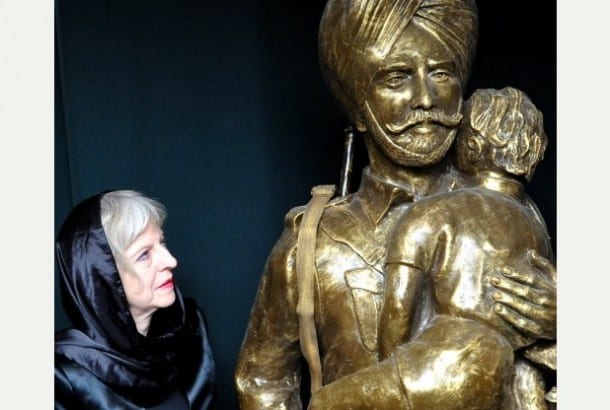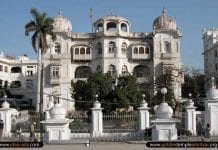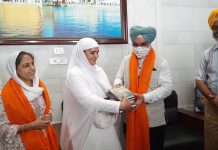

 DERBY, UK—It is not widely known that almost a million Indians fought on the side of Britain during the First World War.Among them, 20% were Sikhs, despite making up only 2% of the Indian population – meaning their contribution was ten times more than any other community in India.
DERBY, UK—It is not widely known that almost a million Indians fought on the side of Britain during the First World War.Among them, 20% were Sikhs, despite making up only 2% of the Indian population – meaning their contribution was ten times more than any other community in India.It is against this background, in the year that the 100th anniversary of the start of the First World War, the Sikh community in Derby has decided to pay its own tribute.
Home Secretary Theresa May was specially invited to the National Sikh Heritage Centre and Holocaust Museum in Princes Street, Derby, today, to unveil two large statues of Sikh soldiers and two plaques – one in English and the other in Punjabi.
The museum – the only one of its kind in the world – was opened in 2009 and is run entirely by volunteers.
Gurmel Singh, secretary general of the Sikh Council UK, said he was delighted that Mrs May had come to Derby for the unveiling.
He said: “She is very popular among Sikhs and recently spoke at the General Assembly of the Sikh Council.
“This museum is very important because it contains a great deal of Sikh heritage. It has put Derby on the map as visitors come to visit from across the world. It has also helped to regenerate this area of Derby.
“We always intended to commemorate the Sikh soldiers who fought in the First World War this year because it is a special anniversary.”
Mrs May was given a tour of the museum during her visit, which currently includes a section devoted to the First World War.
The exhibition includes images of Sikh soldiers, military memorabilia and a soldier’s uniform.
More than 138,000 Indian troops, many of them Sikhs, found themselves in the trenches of Belgium and France during the war, with more than a quarter of them becoming casualties.
After the Battle of Neuve Chapelle in 1915, the Sikh regiments had lost 80% of their men and the three regiments stood at only 16% of their original compliment.
In the first Battle of Ypres in Flanders, in 1914, a platoon of Sikhs died fighting to the last man, who shot himself with his last cartridge rather than surrender. The average Indian battalion had around 764 men when they landed in France, but by November 1914, the 47th Sikhs had only 385 men left.
In Gallipoli, the 14th Sikhs lost 371 officers and men in mere minutes, and thousands of other Sikhs died in various other encounters such as the Somme.
One Sikh soldier, Indar Singh, wrote: It is quite impossible that I should return alive. Don’t be grieved at my death, because I shall die arms in hand, wearing the warrior’s clothes. This is the most happy death anyone can die.”
In total, in the First and Second World Wars, 83,005 turban-wearing Sikh soldiers were killed and 109,045 wounded.
Mrs May said:
I am honoured to be here to perform this ceremony.
The statutes are “thought-provoking” and it is right that we remember and pay tribute to the brave soldiers.
They found themselves on cold European battlefields but answered our call in our hour of need.
They showed great valour and sacrifice to give us the freedoms we enjoy today.
Known as the Lions of the Great War after the war, during the war they were often called the Black Lions.
Sikhs were allowed to use traditional Sikh weapons such as chakrams and talwar swords, and it was not uncommon to see the Sikh holy book, the Guru Granth Sahib, being carried before a marching Sikh battalion or even on the front lines among the battling troops.
Mrs May added: “This museum has been set up so people can see the huge contribution of the Sikhs.”




